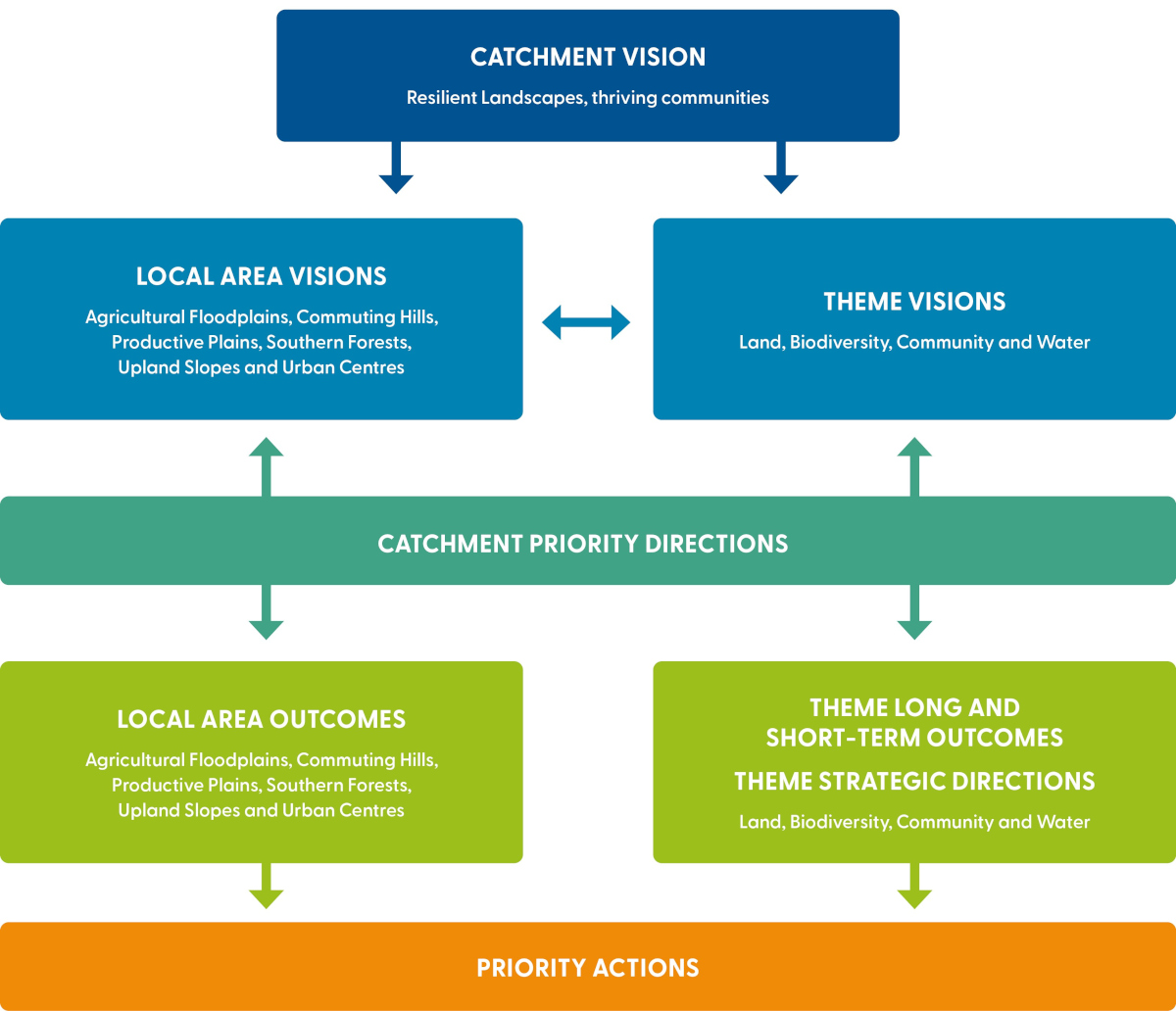The Goulburn Broken Regional Catchment Strategy guides actions to improve and protect the catchment’s natural resources: water, biodiversity, land and community. Looking after these precious natural resources underpins the social, cultural and economic wellbeing of the diverse communities that make up the Goulburn Broken Catchment.
Goulburn Broken Regional Catchment Strategy architecture
The following diagram provides an overview of architecture of the Goulburn Broken Regional Catchment Strategy.

Figure 10: Overall architecture of the Goulburn Broken Regional Catchment Strategy.
Victorian Government legislation
Victorian Government legislation (the Catchment and Land Protection Act 1994) stipulates that each CMA must prepare a strategy for the region and coordinate and monitor its implementation. Each strategy is updated every 6 years and signed off by CMA Boards and the relevant Victorian Government Ministers. The strategy must also be developed with Registered Aboriginal Parties to include First Nations Peoples values and traditional ecological knowledge. Furthermore, the Victorian Catchment Management Council developed state-wide guidelines to assist CMAs renew the strategies.
Strategy renewal process
The Goulburn Broken CMA coordinates the renewal of the Goulburn Broken Regional Catchment Strategy 2021-27 to ensure it provides the best pathways to meet future challenges and opportunities, and is relevant to local communities and organisations. While the Goulburn Broken CMA is responsible for cordinating the strategy, it is a strategy for all organisations, groups and individuals contributing to the catchment’s NRM.
Resilience approach
A resilience approach has been used to guide the strategy’s renewal. This approach to catchment management focuses on the connections between people and place, how these connections change and allows us to consider at what point they could transform the social and ecological systems. Read more about the approach here.
Community and partner feedback
Development of the strategy has involved extensive engagement with individuals, groups and organisations involved or interested in the catchment’s natural resources. This includes Traditional Owners, farmers, environmental volunteers, businesses, local government, public land managers, government agencies and visitors. Engagement involved a review of the previous strategy and development of the Goulburn Broken Regional Insights Paper (2020).
The Goulburn Broken Regional Insights paper presented the findings from the Goulburn Broken 2013-19 review and a socio-economic analysis of the catchment. It also engaged the community early to capture feedback on values, key drivers, socio-economic data, catchment condition and priorities and aspirations for NRM. The Goulburn Broken CMA received over 1,000 comments and ideas from community members along with targeted feedback on the natural resource and local area discussion papers. These have shaped the strategy, particularly the desired outcomes and priority actions.
Lessons and what’s new
The Goulburn Broken community and stakeholders have strengthened their commitment to using a resilience approach to underpin the strategy. This has led to the strategy including key tipping points and a description of the resilience stage (persistence, adaptation, transformation) for each theme. In addition, priority actions have been split into 3 types (established, pathway and transforming) to reflect the resilience stage and community feedback.
Since the last strategy there has been an increasing recognition of Traditional Owners and First Nations Peoples as the custodians of the catchment’s natural resources and the holders of traditional ecological knowledge. This is reflected in the strategy with a stronger emphasis on following the lead of Traditional Owners and supporting their aspirations to become a reality.
The condition of the natural resources is declining from a satisfactory base for water and land and a poor base for biodiversity. This trend is worse than in the last strategy and reflects the impact of drivers such as historical actions, changes in the climate and land use. The strategy has included the importance of environmental stewardship to increase positive actions but with the recognition that volunteer effort alone is not enough.
The community that uses and values the natural resources has changed. Most of the catchment’s population now live and work in towns and value the natural environment to enhance lifestyle rather than for earning a living. Others who use and value the catchment’s land, water and biodiversity live outside the catchment and are not closely connected to the impact of their actions. In response, this strategy aims to engage in new ways with a broader and more diverse group, many who have not been involved in NRM.
The reality of the rapidly changing climate was reflected across the engagement and the review of the condition of the catchment’s resources. The community, industries and stakeholders now acknowledge that climate change is real, that we need urgent action to lead the adaptation and transformation that must occur. In response, this strategy has included climate change and its impacts across all the themes, local plans and priority actions.
Finally, even with the changes across the catchment, 5 key principles have emerged to guide decision-making in NRM at both the catchment and local area scale: strengthen partnerships, community-led, embed resilience principles, supported by science and foster stewardship.
Further information
For further information about the strategy’s renewal click on the links below:
Show your support
Pledge your support for the Goulburn Broken Regional Catchment Strategy and its implementation.



